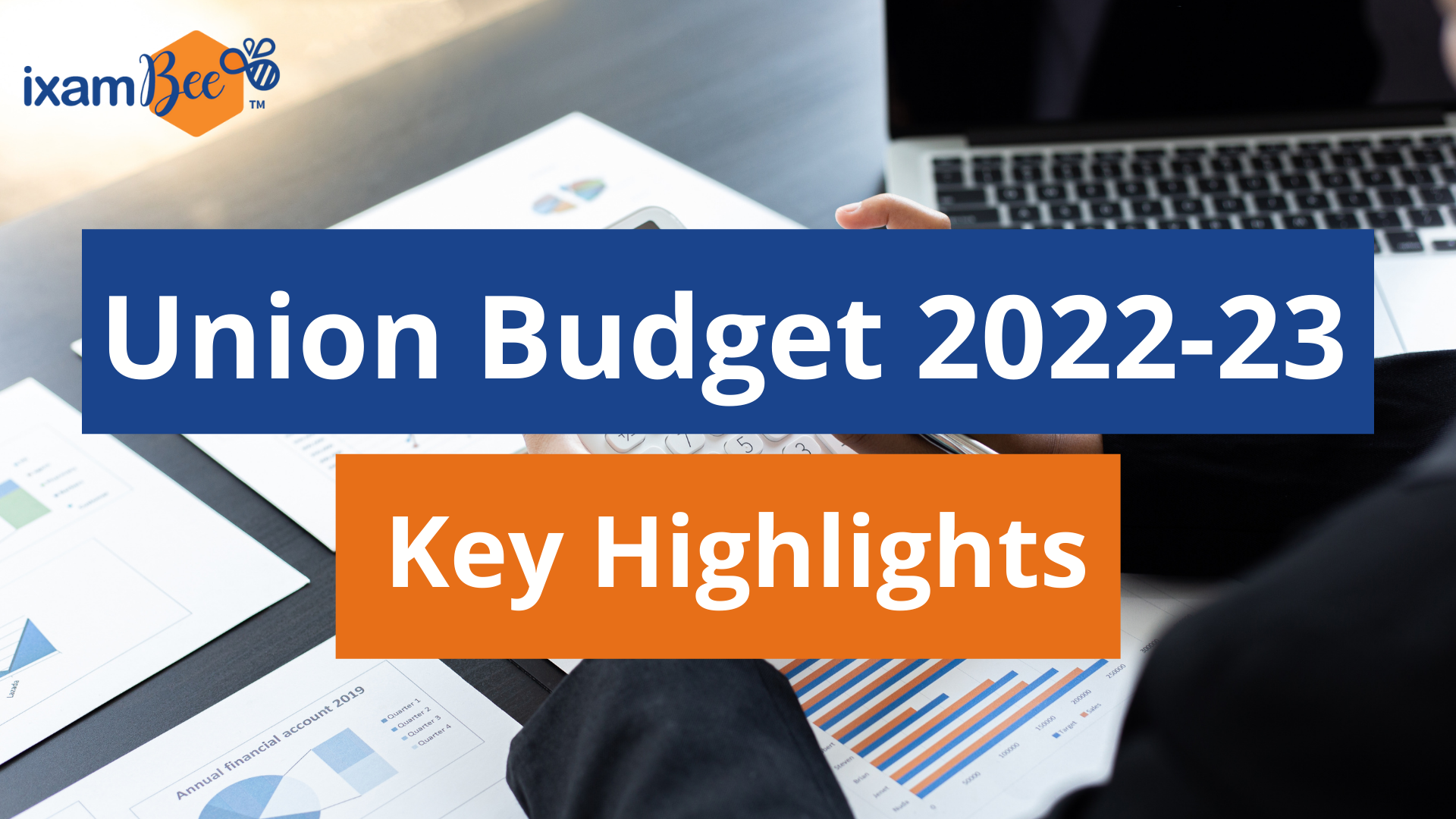The Union Budget is presented every year by the Finance Minister. It was presented on 01 February, 2022 by the Finance Minister Nirmala Sitharaman.
In this article, we will look at the key highlights of the Union Budget 2022-23.

Union Budget: Constitutional Provisions
The Union Budget finds its mention in Article 112 of the Indian Constitution where it is referred to as the Annual Financial Statement. It consists of the receipts and expenditures of the government in the current financial year, previous year and the Budget year. It is divided into three parts-
- Consolidated Fund
- Contingency Fund
- Public Account Fund
Union Budget 2022-23: Theme
The Union Budget of 2022-23 highlights four priorities of the Government of India to help with the long-term growth of the economy.
Union Budget 2022-23: Size
Important Points to Note-
- Total size of the Budget for 2022-23 is Rs. 39.45 lakh crore.
- When it comes to the expenses, the major amount will be on account of Revenue expenditure and Capital expenditure.
- However, there is a substantial increase in the Capital Account expense that the government has budgeted for.
- On the Revenue side, the Revenue receipts has increased substantially (22.04 crores). In the Capital receipts, a major decline is seen in the disinvestment.
- Due to an increase in the revenue receipts, the revenue deficit and all the other deficits are expected to go down. The fiscal deficit will improve to 6.9 percent as against 6.8 percent in 2022-23.
- Higher tax revenue has been budgeted at 11.1% for nominal growth.
- Capital expenditure has also seen an increase from the previous budget (35.4% increase) to support growth in long term.
- Fiscal Deficit is expected to improve to- 6.4% in 2022-23 and 4.5% by 2025-26
Sources
Where does the money come from?
The Government of India earns from various tax revenues like-
GST (16%) —> Corporation Tax (15%) —> Income Tax (15%) —> Union Excise Duties (7%) —> Customs (2%)
Where does the money go?
Union Budget 2022-23: Key Highlights
Given below are the important highlights of the Union Budget of 2022-23
1st Priority- PM Gati Shakti
- The aim of PM Gati Shakti is to ensure coordination among various Ministries for faster and smoother approvals and execution of various projects related to infrastructure development.
- Gati Shakti is not a new concept which has been brought up in the budget. The Government talked about this last year. However, in the Union Budget of 2022-23, the government has formalised it by focusing on sustainable growth and development in the country.
- Here, the main focus is on infrastructure development. The government is going to focus on seven areas– Road, Railways, Airports, Ports , Mass Transport, Waterways and Logistics Infrastructure.
- Clean Energy will be kept in mind while achieving these goals with everybody’s contribution i.e. ‘Sabka Prayas’.
Agriculture
Another aspect covered under Gati Shakti is the Agriculture sector. This year, the government is projecting a growth of 3.9 percent in the Agriculture sector. Let’s look at some important highlights-
- The goal is to promote chemical free natural farming starting with farmers’ lands close to river Ganga- 5km wide corridor.
- To promote post harvest value addition, consumption and branding of millet products.
- Use of ‘Kisan Drones’ will be promoted for crop assessment, digitisation of land records, spraying of insecticides and nutrients.
- Launching fund with blended capital to finance agriculture startups
- Another highlight is the implementation of Ken Betwa Link Project which will benefit 9.1 lakh hectare farm land, providing drinking water to 62 lakh people and generating 130MW power- for which the estimated cost is Rs. 44,606 crore.
- The Budget has also identified 5 such more projects- Damanganga-Pinjal, Par-Tapi Narmada, Godavari-Krishna, Krishna-Pennar and Pennar-Cauvery.
Education
- The focus with respect to education is on skill development and quality education.
- Due to the ongoing Covid-19 pandemic, the school education of children has been hampered as they were unable to go to school.
- The government is aiming at setting up 750 virtual labs for science and mathematics, 75 skilling e-labs for stimulated learning environments in 2022-23.
- Supplementary education in regional languages will be introduced for classes 1 to 12 through a channel called ‘one class-one TV channel’ under the PM eVIDYA scheme. This was currently there for 12 channels and will now be expanded to 200 TV channels.
- A Digital University will be established in the country.
Health
Health is another very important sector covered in the 2022-23 Budget. In 2020, funds were allocated to the health sector for dealing with the Covid-19 crisis. However, this year the allocation continues but from a long-term point of view.
- In 2022-23, the government plans to roll out a National Digital health Ecosystem.
- The idea is to upgrade the existing healthcare system with respect to physical health as well as mental health. For this, the National Tele Mental Programme will be launched for quality counselling.
2nd Priority- Inclusive Development
The second priority of the government is to promote inclusive development. The purpose is to include all types of people so that the benefits can trickle down to the entire population and not just certain segments of the population. The budget highlights seven points with respect to inclusive development-
- The first highlight focuses on water. The Jal Jeevan Mission was also highlighted in the Economic Survey. An allocation of Rs. 60,000 crore was made for Har Ghar Nal Se Jal in the budget. It aims to cover 3.8 crore households in 2022-23
- Another important scheme of the government- PM Awas Yojana got an allocation of Rs. 48,000 crore. The goal is to complete 80 lakh houses in 2022-23.
- The Budget also touched upon PMDevINE which stands for Prime Minister’s Development Initiative for North East. It will provide funds for infrastructure and social development based on needs of the North East. The initial allocation for PMDevIne is Rs. 15,000 crores.
- Aspirational Blocks Programme- for development of lagging blocks of aspirational districts.
- Vibrant Village Programme- to target the development of villages on the Northern Border left out from the development gains.
- Digital Banking by Post Offices- 100 percent of the post offices to be brought under the core banking system.
- Digital Payments- Scheduled Commercial Banks to set up 75 Digital Banking Units in 75 districts.
MSME Sector
Another important sector for inclusive development is the MSME sector. To continue supporting the MSME sector, four aspects are touched upon-
- ECLGS scheme will provide credit to the sector which is backed by the government guarantee. This will be extended upto March 2023. The Guarantee cover has been expanded by Rs. 50,000 crore to cover a total of 5 lakh crore, with additional amount being earmarked exclusively for hospitality and related enterprises.
- CGTMSE scheme stands for Credit Guarantee Scheme for Micro and Small Enterprises. It will provide additional credit of Rs. 2 lakh crore to Micro and Small Enterprises and expand employment opportunities.
- A new programme will be launched- Raising and Accelerating MSME Performance (RAMP). It has been given an allocation of Rs. 6,000 crore over 5 years for raising and accelerating the performance of MSME.
- Portals like Udyam, e-Shram, NCS and ASEEM portals will be interlinked.
3rd Priority- Productivity Enhancement and Investment
With respect to this priority, the aim of the government is to improve the ease of doing business in our country, the ease of living and support the economy.
- Production Linked Incentive (PLI) scheme is one the most important aspects related to the third priority.
- The Telecom sector is now under the PLI scheme to support the 5G rollout.
- Trust-based governance is included in ease of doing business.
- There will be integration of central and state level systems through IT bridges and expansion of PARIVESH Portal.
- Another important aspect highlighted is the Defense sector. It states that 68 percent of the capital procurement budget will be earmarked for domestic industry in 2022-23.
- This priority also focuses on the clean energy aspect. The government is focusing on domestic manufacturing for the ambitious goal of 280 GW of installed solar capacity by 2030. For this, Rs. 19,500 crore has been allocated for the PLI for the manufacturing of high-efficiency modules. This will enhance the manufacturing sector and focus on clean energy as well.
4th Priority- Financing of Investment
For this final priority, the focus is on the capital expenditure. The government is prioritising capital expenditure. There has been an increase of 35 percent in the budgeted expense for the capital expenses.
- The government has used the term ‘crowd in’ which means that it will bring in the private sector in the capital formation of the country.
- RBI will introduce Digital Rupee in 2022-23 keeping in line with the Central Bank Digital Currency mentioned by RBI in 2020.
- More fiscal space will be given to States.
- For 2022-23, States will be allowed a fiscal deficit of 4 percent GSDP of which 0.5 percent will be tied to power sector reforms.
Tax Proposals
- From the Direct tax point of view, the proposals are more to ease the process. There are no cuts or changes in the slabs.
- Income from transfer of virtual assets to be taxed at 30 percent. This is majorly focusing on cryptocurrency transactions.
- There is an increase in tax deduction limit on employer’s contribution to NPS accounts of state government employees. For central/state government employees the NPS contribution is compulsory and the government also contributes. For central government employees the government contributes 14 percent of the salary. Similarly, for the state government employees, the government’s contribution was 10 percent. This limit is now increased to 14 percent to match the central government employees in 2022-23.
- Taxpayers will now be allowed to file updated returns within 2 years for correcting any errors.
- A tax relief is brought in for persons with disabilities.
- For cooperatives, there has been a reduction in the Alternative Minimum Tax rate to 15 percent (from 18.5 percent). Surcharge has also been reduced to 7 percent (from 12 percent).
Major Schemes
Some schemes have got allocations across different sectors.
Conclusion
To sum up, having knowledge of the Union Budget and Economic survey is essential for various government and banking exams like- RBI Grade B, SEBI Grade A, IBPS PO, IBPS SO, SBI PO and many others. Therefore, we encourage you to read this article very carefully.
Get Free Online Test Series, GK updates in the form of BeePedia. Similarly, get the latest updates for Bank PO, Bank Clerk, SSC, RBI, NABARD and Other Government Jobs as well.
Also Read
Are SEBI Employees Allowed to Trade?
National Startup Day: Role & Significance















